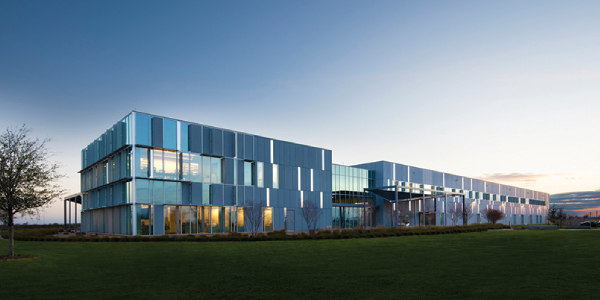Are insulated metal panels the future of material systems?

By Emma Peterson.
Learn why the industry is shifting away from traditional material systems in favor of insulated metal panels in this continuing education course.
The material chosen for the building envelope should not only meet the code criteria that already exists, but also be designed to adapt to anticipated shifts in future code. A continuing education course sponsored by Metal Construction Association's (MCA) Insulated Metal Panel Alliance outlines how insulated metal panels (IMPs) stand out from traditional materials such as tilt-up concrete.
What are IMPs?
IMPs are a lightweight solution designed to be installed in exterior walls and roofs. They are made up of metal skins, typically galvanized or aluminum-zinc coated steel. An expanding polyurethane foam is injected into the core of the panel, which imparts excellent insulation performance. Overall, these panels are known for their superior insulation and efficient, one-pass installation.
Further, IMPs are popular for their adaptability. As they are available in many colors, widths, profiles and finishes, architects and contractors can get the exact insulation values, span lengths and capabilities they need for each project. Further, panels can be manipulated easily, with adaptable bending options, integrated windows and countless finish options. RC Antal, director of insulated metal panels for ATAS International summed up the incredible opportunity this provides when he told the the MCA, “The realization of virtually any design for walls and roofs is possible [with IMPs].”
What are the traditional materials?
The primary competition for IMPs are traditional materials, such as tilt-up concrete. Tilt-up is created by casting large concrete panels on site and then using a crane to raise them into position. This style of building gained popularity for its wide availability, strong durability and natural fire-resistant qualities. However, as technology advances, some of the limitations of this material have begun to reveal themselves. One example of this is the limitations to aesthetics. Tile-up panels are limited to solid color and the finishes are created in the field, lowering the level of control possible.
Conclusion
Overall, the newer technology of IMPs stands up well against the traditional material systems. IMPs are proven to be more energy efficient and easier to install than tilt-up concrete panels. Further, where tilt-ups' color and finishes are dependent on field work and environmental factors, IMPs are designed in controlled environments. This means that they have warranties of over three decades and can offer a wider variety of low-maintenance finishes, such as mica, metallic, wood grain and prismatic. As an added bonus, using IMPs can create an opportunity for a project to earn sustainable certifications and a healthier job site.
Check out the rest of the course from the MCA to see case studies of IMPs in action and then test your knowledge with their online quiz! This can be self-reported for a variety of organizations’ continuing education requirements.
Learn more about Metal Construction Association (MCA) in their Coffee Shop Directory or visit www.metalconstruction.org.
About Emma
Emma Peterson is a writer at The Coffee Shops and AskARoofer™. Raised in the dreary and fantastical Pacific Northwest, she graduated in 2024 from Pacific University in Oregon with a degree in creative writing and minors in graphic design and Chinese language. Between overthinking everything a little bit, including this bio, she enjoys watching movies with friends, attending concerts and trying to cook new recipes.
Recommended For You

How you can master the subcontractor process
Read More ...
Leaping at New Opportunities
Read More ...
Diving into all things liquid-applied roof systems
Read More ...

















Comments
Leave a Reply
Have an account? Login to leave a comment!
Sign In